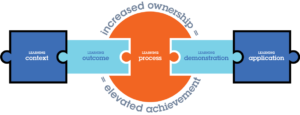Share this article.
We at Elevated Achievement believe that in order for each and every learner to achieve at higher levels they must own their learning. We believe that learners can be taught to own their learning. And, we have said this before, but it cannot be stated enough: We believe that learning should not be exclusive to our students. Its power is expanded when there is a community of adults who have the skills necessary to elevate student achievement. In other words, we believe all adults in a student’s community must actively engage in professional learning opportunities that ultimately will benefit the student.
That’s we wrote this series of articles for all educators who believe in building a learning community. And now this is the perfect time to provide the knowledge and tools school-site administrators and/or presenters need to implement a focused Learning Model for Adults for each and every professional learning session they provide to staff, teachers, and parents and caregivers.
In other articles, we provided an overview of the Learning Model for Adults and its five phases: setting the Learning Context, stating the Learning Outcome, engaging in the Learning Process, producing the Learning Demonstration, and implementing the Learning Application. We also discussed the planning sequence and provided examples of professional learning sessions that elevate student achievement.
In this article, we take an in-depth look at two of the five phases that engage adults in learning and lead to elevated achievement, the Learning Context and its counterpart Learning Application.
Setting the Learning Context
This is the phase of the session during which the session is introduced to the adult learners and placed within a context. Context includes informing learners about what they will learn, why this learning is important, and how it connects to various situations as they use the session learning to support student achievement. Most importantly, this phase helps learners begin to answer the question, “Why am I learning this?”
While setting the Learning Context, the presenter clearly and specifically introduces what adult learners will be learning, why it is important to them, how this learning connects to various situations, and how they will use the session learning to support student achievement. This information will be restated during the Learning Application.
The Value of Knowing the Learning Context
If adult learners know why they are learning something, they are more motivated to…
- Engage in what the session’s learning is because they know why it is relevant to them.
- Connect the learning to increased student achievement.
- Ensure that the learning is implemented and supportive of student success.
In other words, the value is having a session of adult learners who will be supported in and committed to elevating student achievement. Instead of just one teacher, students will have a community of support.
To help you make stronger learner-centered decisions, consider these questions as you plan:
- Why are they learning this?
- How will today’s learning support student achievement?
- How will you share this information with your participants?
Clarifying the Learning Application
This is the phase of the session during which connections are made from the current learning to various situations as they use the session learning to support student achievement. Clarity of future application is crucial for adult learners to retain the skill or content, apply the skill or content in a variety of ways, and transfer the skill or content to other situations. This phase helps learners answer the question, “How will I continue to use what I have learned?”
While implementing the Learning Application, the presenter offers the adult learners various opportunities during which they can apply the learning in a variety of ways, reflect on their learning and their growth, and develop stronger metacognition. This information was first given to the participants during Learning Context.
The Value of Knowing the Learning Application
If adult learners know how they will continue to use what they are learning, they are more motivated to…
- Engage in and articulate what the session’s learning is and how it will be applied in the future.
- Connect the learning to increased student achievement.
- Ensure that the learning is implemented and supportive of student success.
In other words, the value is having a session of adult learners who will supported in and committed to elevating student achievement. Instead of just one teacher, students will have a community of support.
To help you make stronger learner-centered decisions, consider these questions as you plan:
- How will today’s learning support student achievement?
- How will your participants use this learning in the future?
- How will you share this information with your participants?
Keep Developing Learnership
Students deserve a community of adults committed to learning skills that will increase student achievement. Therefore, it is critical for presenters to deliberately make the decisions that will increase adults’ engagement in learning and overall motivation. The best decision a presenter can make is to utilize a focused Learning Model for Adults when planning professional learning sessions.
That’s why we are providing these articles that take in-depth looks at each of the phases of the Learning Model for Adults, their value to student achievement, and the planning questions and tools needed for implementation. The following sequence for reading is recommended as you plan with a focused Learning Model for Adults.
- First, read this current article to learn how to determine the Learning Context, and the Learning Application. In other words, read this article to get the planning questions and tools you need to determine why the learning is important to adult learners and how they will use it in the future.
- Next, read “How to Ensure Adult Learners to Use What They Know to Elevate Student Achievement” to learn how to determine the Learning Outcome and the Learning Demonstration. In other words, read that article to get the planning questions and tools you need to determine the specific skills adult learners are learning and what a demonstration of mastery will look and sound like.
- Finally, read “How to Actively Engage Adult Learners in the Learning Process” to learn how to determine the Learning Process. In other words, read that article to get the planning questions and tools you need to determine the instructional strategy or strategies that will allow adult learners to most effectively and efficiently demonstrate mastery of the learning outcome.
Then you’ll be ready to backward plan a session and deliver instruction throughout that session with the end in mind as you move through the five phases: setting the Learning Context, stating the Learning Outcome, engaging in the Learning Process, producing the Learning Demonstration, and implementing the Learning Application.
Continue the Learning
Check out these articles and resources to continue your learning about this topic…
The Learning Brief
In this article you learned…
- The Learning Context is the phase of the session when the presenter informs adult learners about what they will learn, why this learning is important, and how it connects to various situations, and this information is restated during the Learning Application
- The Learning Application is the phase of the session during which connections are made from the current learning to various situations where the participants can use the session learning to support student achievement.
- Adult learners who know why they are learning something and how they will use it are more motivated to engage in the session, connect the learning to increased student achievement, and ensure that the learning is implemented and supportive of student success.
Can you imagine building an environment full of motivated, engaged, and eager students who own their learning?
We can.


